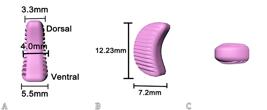ABSTRACT:
Several surgical procedures aim to decompress and/or stabilize the lumbosacral (LS) joint of dogs; however, the lumbar interbody fusion technique, by using a cage combined with a bone graft, is the most indicated and used in human medicine. No specific implant is available for application to the canine lumbosacral joint. Thus, this study measured lumbosacral discs in large dogs, determined whether a human cage model could fit the dogs’ L7-S1 intervertebral space, and developed a LS cage prototype for dogs. Ten cadaveric lumbosacral spines from adult dog weighing 20-35kg were used. The dogs had died for reasons unrelated to this study. The vertebral body dimensions and the L7-S1 intervertebral space occupied by the intervertebral disc were measured by lateral and ventrodorsal radiographs and by computed tomography in the dorsal, sagittal, and transverse views. Measurements were also taken of the anatomical specimens in the sagittal and transverse planes. After measuring the intervertebral discs, the following mean measures were obtained for L7-S1 discs: height 12.23mm, dorsal thickness 3.3mm, central thickness 4mm, ventral thickness 5.5mm, and width 24.74mm. The human lumbar cage models from brands LDR, Baumer Orthopedics, Stryker, Synthes, and Vertebral Technologies, Inc. and cervical stabilization cages from the brands B-Braun and Stryker were evaluated and were found to be unsuitable for large dogs. Cervical human cages had measurements similar to those found in this study; however, due to their quadrangular shape, the possibility of being introduced surgically through the surgical accesses available for the articulation between L7-S1 in dogs without injuring the cauda equina or the L7 root is small. A cage model was then developed using 3D modelling software. It was designed for insertion via dorsal laminectomy in the lateral portions of the intervertebral space. To avoid cauda equina lesion, the implant model was developed to be placed laterally to the midline. The cage surface is serrated to prevent using the locking screw to fix it, thus avoiding further injury to nerve structures. The serrated surfaces are also designed to avoid cage migration and promote stability. The prototype allows graft placement in the surrounding intervertebral space, which is fundamental for fusion through integration between the cage and the endplates as well as for bone growth between and around the cage. It was also considered studies on humans showing that the lateral regions of the endplates support a more considerable load. Biomechanical and in vivo studies on the developed model are necessary to evaluate the actual degree of distraction, mobility and the long-term rate of fusion between L7 and S1 and its possible impact on the adjacent motor units, combined or not with dorsal fixation techniques.
INDEX TERMS:
Lumbosacral; intervertebral cage; prototype; degenerative diseases; surgery; dogs

 Thumbnail
Thumbnail
 Thumbnail
Thumbnail
 Thumbnail
Thumbnail
 Thumbnail
Thumbnail
 Thumbnail
Thumbnail




